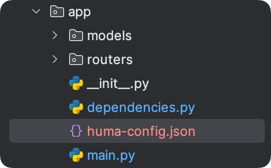Quick Start: Backend integration
Overview
This guide provides step-by-step instructions to integrate our product into your system.
Prerequisites
- Access to Huma Admin Portal.
- Installed Huma Python Client
- Huma Android/iOS SDK integrated in your project.
Steps to Integrate
1. Obtain and Configure API Domain and Client Details
- Log in to the Huma Workspace.
- Download the huma-config.json file with secrets provided for your integration.
- Add it to your project directory.

- Install python client
pip install huma_python_client
2. Initialize library
Basic initialization is pretty simple, just provide the path to your huma-config.json and your deployment id.
from huma_python_client import HumaApiClient, ClientType
client = HumaApiClient(config_file="config.json")
# Register a new user
response = client.register(
email="user@example.com",
first_name="FirstName",
last_name="LastName",
client_type=ClientType.IOS,
deployment_id="5d386cc6ff885918d96edb3a"
)
print(response)
# Login a user
response = client.login(
email="user@example.com",
client_type=ClientType.IOS,
deployment_id="5d386cc6ff885918d96edb3a"
)
print(response)
Endpoint Implementation Example
User authentication should be handled via your original endpoints. The "Get Huma Token" endpoint (for example: {domain}/private/huma-token) should be protected and based on the current authenticated user, perform the requests to Huma backend.
To implement the private/huma-token endpoint:
- Attempt to sign in the user using the
client.login()method. - If the user does not exist (returns a 403 status), sign them up using the
client.register()method. - Return the tokens and user ID (uid) received from the Huma backend.
The following example demonstrates how to implement the private/huma-token endpoint.
from fastapi import APIRouter, Depends
from huma_python_client.client import HumaApiClient
from huma_python_client.exceptions import UserDoesNotExistError as HumaUserNotExistError
from app.dependencies import authenticate
from app.models.database import User
from app.models.responses import HumaTokenResponse
from app.models.user import HumaTokenRequestBody
router = APIRouter(prefix="/private", dependencies=[Depends(authenticate)], tags=['Huma'])
@router.get("/huma-token")
def get_huma_token(request_body: HumaTokenRequestBody = Depends(), current_user: User = Depends(authenticate)) -> HumaTokenResponse:
"""
Interacts with Huma backend to auth the user and provide the auth and refresh tokens for Huma sdk.
"""
huma_deployment_id = "***PUT YOUR DEPLOYMENT ID HERE***"
huma_client = HumaApiClient(config_file="huma-config.json")
try:
rsp_json = huma_client.login(current_user.email, request_body.client_type, huma_deployment_id)
except HumaUserNotExistError:
rsp_json = huma_client.register(current_user.email, current_user.firstName, current_user.lastName, request_body.client_type, huma_deployment_id)
return HumaTokenResponse(**rsp_json)
Conclusion
By following these steps, you can integrate our product seamlessly into your system. If you have any questions or need further assistance, please contact our support team.